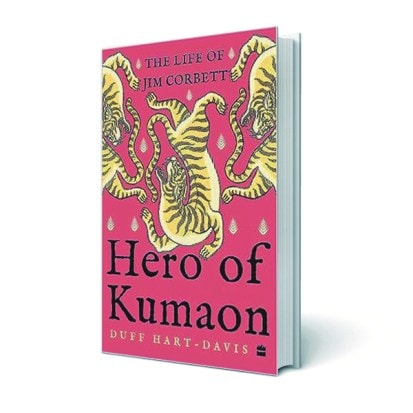Hero of Kumaon: The Life of Jim Corbett
Duff Hart-Davis
HarperCollins
Pp 272, Rs 399
Jim Corbett was someone who donned multiple hats of a hunter, conservationist, naturalist, author, and hero. It is said that he was gifted with exceptional observational skills and strong hunting instincts. He could even imitate the calls of birds and animals. ‘Sure-footed’ like a goat, he was able to follow the movements of tigers and leopards in the jungle whether it was day or night.

The book Hero of Kumaon by Duff Hart-Davis is a compilation of excerpts from some of the best-selling works of Jim Corbett, giving a detailed account of his life-and-death encounters with tigers and leopards in Indian jungles. It also details how he happened to become the man behind Corbett National Park. Davis, a naturalist himself, has tried to piece together the narratives and the adventures of Corbett and the way he acquired a god-like reputation after rescuing locals from man-eating big cats. Born on July 25, 1875, in Nainital, Corbett was drawn towards wildlife since childhood and would identify animals and birds by their calls.
Worshipped by people and decorated by the government for his efforts to reduce the conflict between animals and humans, Corbett became quite a hero among hill people. The locals would call him ‘Carpet Sahib’ in their rustic language. While the tigers terrorised the Kumaon hills and the locals, he could call the big cats to him and ‘converse’ with them.
The biographical account takes the reader into the jungles and helps one discover how Corbett metamorphosed from a ‘killer’ to an avid conservationist, which ultimately resulted in a national park being named in his honour. Davis has also retains Corbett’s own narrative in the book and has quoted him on several occasions.
The book also throws light on the times when hunting big cats was quite a fad and pursuit of them was considered to be exciting. Farmers were paid rewards for their destruction as they were considered to be vermin.
One of the chapters of the book, The Champawat Man-Eater, mentions the maiden experience of Corbett killing a tiger. The fearsome beast, a tigress, had killed 200 people in Nepal and 234 in Kumaon by then. The villagers looked upon Corbett as a ray of hope as they had been held hostage in their own homes. After a gruesome trail, Corbett finally shot it dead and put an end to its reign of terror, much to the respite of the villagers, who hailed him as a hero. After his ‘heroic’ act, he was recognised by the government, which gave him an unlimited licence to patrol the reserved forests.
The reader also discovers how a hunter like Corbett was frightened by some supernatural phenomenon during his exploits in Champawat. As Corbett is quoted: “I have a tale to tell of that bungalow, but I will not tell here, for this is a book of jungle stories and ‘tales beyond the laws of nature’ do not consort well with such stories.”
Through 256 pages, the book details different phases in Corbett’s life. He turned into a conservationist and author from being a hunter, though he hated to be called one. “The thought itself is hateful to me, for it makes me feel so cheap,” Corbett said when a rumour got around in New York that he was a professional hunter.
The subsequent chapters—The Man-Eating Leopard of Rudraprayag, The Chowgarh Tigers, The Mohan Man-eater, etc—talk of his showdowns with the fiercest of the big cats and also how he dedicated the later part of his life to preserving the dwindling population of the tigers. His last man-eater kill was Thak Man-eater in 1938. Corbett left India in 1947 along with his sister Maggie. In the same year, he pegged the tiger population at 3,000-4000 and predicted that in many parts of India, tigers will become extinct in the next 10-15 years.
Corbett’s legacy continues even after he settled down in Kenya. The Ramganga National Park was renamed as Jim Corbett National Park and the biggest step to preserve tigers was taken in 1973 in the form of Project Tiger. The dwindling statistics of tigers (only 1,200 remained in the whole of India in April 1973) mentioned towards the end of the book come as a shock to the reader as the number of tigers was in lakhs during the early chapters of his hunting expeditions.
Corbett died on April 19, 1955, but he continues to live on through his work. The book brings the ‘Hero of Kumaon’ to life again, though it lacks exclusivity at the writer’s end.
A delight for wildlife enthusiasts, it also celebrates Corbett as an author. He authored some bestsellers like Man-Eaters of Kumaon, Jungle Lore, etc. The reader discovers for herself why Corbett was called a man of many talents.








